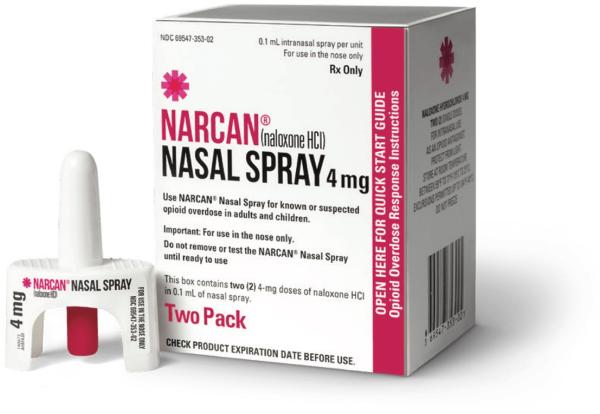Naloxone Side Effects
Applies to naloxone: injection solution.
Other dosage forms:
Serious side effects of naloxone
Along with its needed effects, naloxone may cause some unwanted effects. Although not all of these side effects may occur, if they do occur they may need medical attention.
Check with your doctor immediately if any of the following side effects occur while taking naloxone:
Incidence not known
- agitation
- body aches
- chest pain
- coughing that sometimes produces a pink frothy sputum
- crying more than the usual (in babies)
- diarrhea
- difficult or trouble breathing
- excessive crying
- fast, pounding, or irregular heartbeat or pulse
- fever
- goosebumps
- increased or excessive unconscious or jerking movements
- irregular, fast or slow, or shallow breathing
- irritability
- nausea or vomiting
- nervousness
- pale or blue lips, fingernails, or skin
- restlessness
- runny nose
- seizures
- shivering
- sneezing
- sweating
- swelling in the legs and ankles
- trembling
- weakness
- yawning
For Healthcare Professionals
Applies to naloxone: compounding powder, injectable kit, injectable solution, nasal spray, oral solution.
General
This drug may precipitate abrupt opioid withdrawal in physically dependent persons; signs and symptoms may include body aches, fever, sweating, sneezing, yawning, nausea, vomiting, sweating, lacrimation, rhinorrhea, cramping, insomnia, chills/hot flashes, piloerection, tachycardia, anxiety, restlessness, irritability, tremulousness, hypertension, seizures, and cardiac arrest. In the neonate, opioid withdrawal may also include convulsions, excessive crying, and hyperactive reflexes.[Ref]
Cardiovascular
- Common (1% to 10%): Tachycardia, hypotension, hypertension
- Uncommon (0.1% to 1%): Arrhythmia, bradycardia
- Rare (less than 0.1%): Fibrillation, cardiac arrest
- Frequency not reported: Left ventricular failure, flushing[Ref]
In postoperative patients, many of whom had cardiovascular disease, the following cardiovascular side effects have been reported: hypotension, hypertension, atrial and ventricular tachycardia, ventricular fibrillation, left ventricular failure, and cardiac arrest. Death, coma, and encephalopathy have been reported as sequelae of these events.[Ref]
Nervous system
- Common (1% to 10%): Dizziness, headache
- Uncommon (0.1% to 1%): Tremor
- Rare (less than 0.1%): Seizures
- Frequency not reported: Coma, encephalopathy, convulsions, paraesthesia, grand mal convulsion[Ref]
Death, coma, and encephalopathy have been reported as a result of abrupt postoperative reversal of opioid depression, primarily in patients with preexisting cardiovascular disorders or in those who received other drugs with similar adverse cardiovascular effects.[Ref]
Respiratory
- Very rare (less than 0.01%): Pulmonary edema
- Frequency not reported: Dyspnea, respiratory depression, hypoxia, nasal dryness, nasal edema, nasal congestion, nasal inflammation[Ref]
It has been suggested that pulmonary edema may be due to a centrally mediated massive catecholamine response leading to a dramatic shift of blood volume into the pulmonary vascular bed resulting in increased hydrostatic pressures.
Nasal dryness, nasal edema, nasal congestion, and nasal inflammation were the most common adverse reactions reported in clinical trials with naloxone nasal spray.[Ref]
Local
- Frequency not reported: Nonspecific injection site reactions, irritation of vessel was after IV administration[Ref]
Gastrointestinal
Dermatologic
Hypersensitivity
- Very rare (less than 0.01%): Allergic reactions including urticaria, rhinitis, dyspnea, Quincke's edema, anaphylactic shock[Ref]
Psychiatric
- Frequency not reported: Agitation, hallucination, tremulousness[Ref]
Musculoskeletal
- Frequency not reported: Musculoskeletal pain[Ref]
Musculoskeletal pain was one of the more commonly reported adverse reactions in clinical trials with naloxone nasal spray.[Ref]
References
1. (2001) "Product Information. Narcan (naloxone)." DuPont Pharmaceuticals
2. Cerner Multum, Inc. "UK Summary of Product Characteristics."
3. Cerner Multum, Inc. "Australian Product Information."
Frequently asked questions
- How do I get free Narcan emergency kits?
- How long does Narcan (naloxone) block opiates?
- What are the different types of buprenorphine/naloxone?
- How do you administer Narcan (naloxone)?
- How does Narcan (naloxone) work in an overdose?
- Is this an addictive drug?
- What's the difference between naltrexone and naloxone?
- Will naloxone show up on a drug test?
- Does Sublocade have naloxone in it?
More about naloxone
- Check interactions
- Compare alternatives
- Pricing & coupons
- Reviews (26)
- Latest FDA alerts (2)
- Dosage information
- Patient tips
- During pregnancy
- Support group
- Drug class: antidotes
- Breastfeeding
Patient resources
Other brands
Narcan, Evzio, Kloxxado, Rezenopy, ... +2 more
Professional resources
- Naloxone Hydrochloride monograph
- Naloxone (FDA)
- Naloxone Auto-Injector (FDA)
- Naloxone Injection (FDA)
- Naloxone Nasal Spray (FDA)
Other brands
Narcan, Evzio, Kloxxado, RiVive, Zimhi
Related treatment guides
Further information
Naloxone side effects can vary depending on the individual. Always consult your healthcare provider to ensure the information displayed on this page applies to your personal circumstances.
Some side effects may not be reported. You may report them to the FDA.

